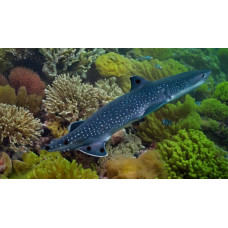Latin name
Parascyllium variolatum
Other name
Parascyllium variolatum
Identification
The necklace carpetshark has a slender, elongated body and a short snout. The mouth is located in front of the eyes, there are narrow nasal furrows and the nostrils are surrounded by wrinkles. The slit eyes are horizontally elongated. There are tiny spiracles behind the eyes.
Features of fish fins
The base of the first dorsal fin of these sharks is located behind the free tip of the pelvic fins. The dorsal fins are of equal size and there are no spines at their bases. The pectoral fins are rounded. The anal fin is smaller than the second dorsal fin. The caudal fin is asymmetrical, with a ventral notch on the edge of the upper lobe. The lower lobe is absent.
Fish colouring
The Necklace Carpetshark has a characteristic "necklace" around the gill zone, which is a multitude of white spots on a monotonous dark background. The body, tail and caudal fin are covered with dark markings. The fins are covered with large dark spots.
Distribution
Necklace carpetsharks are found in the eastern Indian Ocean. They are endemic to the temperate waters off the southern coast of Australia (Victoria, Tasmania, Western and South Australia).
Habitat
Demersal marine species. These sharks are found along the continental shelf at depths of up to 180m.
Size
The maximum length of a male of this species is 91.0 cm.
Behavior
These sharks are nocturnal and hide in shelters during the day. They inhabit a variety of habitats including sandy bottoms, rocky reefs, seaweed thickets and seagrass beds.
Food and feeding habits
This type of fish feeds on molluscs, crustaceans and other small creatures that live on the bottom of shallow or surface waters.
Reproduction
Necklace carpetsharks reproduce by oviposition. The embryos feed exclusively on the yolk.
Fishing
These sharks are not fished commercially. They are occasionally caught as by-catch in fishing nets.
Relationship with a person
A species of shark that is harmless to humans.
| Classification | |
| Phylum | Chordata |
| Class | Chondrichthyes |
| Squad | Orectolobiformes |
| Family | Parascylliidae |
| Genus | Parascyllium |
| Species | P. variolatum |
| Features | |
| Conservation status | Least Concern |
| Habitat | Bottom |
| Life span, years | No information |
| Maximum body weight, kg | No information |
| Maximum length, cm | 91 |
| Sailing speed, m/s | No information |
| Threat to people | Not edible |
| Way of eating | Bentophage |
Necklace carpetshark
Tags: necklace carpetshark

